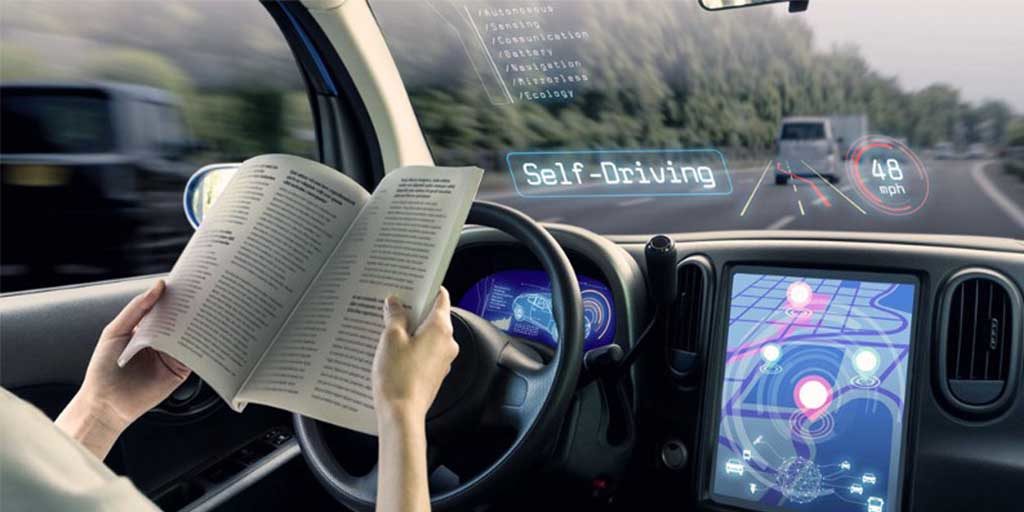Technology Landscape
A Personal View of Sector Impacts
Interview by Caragh O’Carroll, Fujitsu
Sitting on my father’s knee, I didn’t think about the future. I was just entranced by the tiny springs and gears as he made and fixed watches. How each tiny piece had an important job to do and without that the whole couldn’t work.
I didn’t think about it much either as I took science subjects, entered a project into the Young Scientists or took on mechanical engineering in college. It was just they all felt right. It wasn’t until many years later that someone asked ‘really — tell me about you’ that I understood loving technology, explaining it, making it simple to understand is what I’m all about.
Generalized internet use was just starting in the mid-90s. I still remember vividly writing my first work email, as well as connecting 2 companies’ work management systems and processes via a very early extranet. Whether it’s been global projects to roll out secure networks for later sale to customers, managing the launch of new telco products or managing strategic and niche technology partnerships, it’s all focused on one thing: where does new technology fit and why have it in the first place.
There are always mega trends, but a big trend is nothing if it can’t be articulated and applied. The key is to understanding different industries and their needs. Take these, for example:
Retail
True personalized, unified omnichannel experiences are coming to the fore. Retailers are focussing on customers as individuals and providing a consistent experience across online and store channels, based on data capture analytics for upsell recommendations and promotions.
There’s a large dependency on an architecture supporting integration between ecommerce, fulfilment, order management, warehousing, delivery and Point of Sale/Service solutions to make this happen.
Increased demographics are being used to understand store visitor behaviour, just as websites have used for years — where do we go, how long do we stay, what seems to be interesting to us, can we target customers better if we understand them more.
There are lots of concerns about privacy and data protection, that vital balance of anonymized information to help you understand how people are visiting your store versus identifying individuals and joining that information up with purchase history, loyalty schemes and other data sources such as social media feeds. Can you articulate what data is being gathered, how it’s used, secured and shared?
Sales associates will need improved digital workplace solutions — with 60% of transactions to be performed over mobile Point of Sale, checkout will come to you and will also assist you with shop- floor product queries. Clever tools to increase shopping time and avoid queuing, to maximize spend from fitting room visitors through smart mirrors, to use self-scanning to speed up checking out. Stores won’t die out but their nature will change to provide differentiated experiences.
Transport
Autonomous vehicles exist and promise a safer, more predictable transport future. They depend highly on sensors, analytics and connectivity. With many technical obstacles now overcome, more field trials are expected. Ultimately, we need public confidence and the infrastructural and insurance solutions to enable widespread use in the future.
Security is everywhere and underpins the success of all initiatives. With a security-from-the-start mindset, we have to build in layers of protection from external and internal threats, whether it’s a human-operated, robotically operated or artificial intelligence system.
The number of security solutions continues to grow and a managed adaptive security management framework is essential as the threat landscape evolves across all sectors. With tools such as facial and vehicle recognition and biometric access control now available to companies on a widespread basis, physical security is evolving as well as cyber security.
Improving the customer or passenger experience is going to happen in other ways also. Building in a smart queuing app or service enhancement option to your travel app allows passengers to seek assistance when arriving at a transport hub, store or venue as visitors virtually book their place in a queue without having to stand physically waiting. Way-finding solutions will also enable smoother experiences.
By giving back time and energy to your service users and customers, you improve their experience and can differentiate. The development of AI translation devices means less communications difficulties. There is certainly a trend towards people-centric solutions.
Utilities
With a major focus on customer service change, utilities view AI-augmented customer service agents, particularly digital customer service agents as a way to improve service offerings. This may manifest as voicebots, chatbots, interactions with home energy sensors/IoT and with virtual private assistants (e.g. Alexa, Google Home). This change is being driven by the service expectations of future customers (millennials, GenZ) and most utilities are expected to establish new business transformation units to achieve this change and provide capabilities in this area. The IT impact comes from establishing access for Virtual Customer Assistants and Virtual Executive Assistants to corporate ERP applications and other knowledge sources to enable effective customer service.
In energy generation, microgrids will gain traction in emerging markets in an ‘as-a-service’ model and blockchain will be useful in managing peer-to-peer (‘prosumer’) microenergy transactions. Renewables continue to be a major contributor as solar generation cost is falling sharply.
With AI also being embedded in strategic oil and gas applications by software vendors, a need for AI skills within IT teams will arise for those with propensity for building custom applications and integrations.
The use of asset performance management systems is expected to become mainstream to improve operational performance. Digital twins (digital and physical versions of assets), 3D models and mixed- reality solutions will be integrated into an overall digital platform enabling assets to be optimized during the design phase. Creating this platform will rely more on IT than OT (Operational Technology) skills.
Digital disruption is expected and having focussed on cost-cutting through recent years, oil and gas CIOs will be tasked on identifying and implementing digital innovations.
In order to limit security challenges, utilities companies are expected to adopt a new security posture focussed on resiliency and enhancements to both IT and OT physical and cyber security. The move to more digitally-oriented customer service will also require data privacy by design as a key pillar of those projects.
The move to mobile is a key one with debate centering on whether the mobile platform will be solely for balance/usage reporting, will it include customer services capabilities, will it be used to sell additional services such as boiler servicing?
With future expectations of micro-generation, the same platform could be used to manage selling back to the grid as well as consuming from the grid.
This all depends on an open data strategy across the organization so that these services can be provided. Additionally, the Integrated Single Electricity Market relies on data-sharing by power generators on a widespread basis to enable dynamic and forward trading.
Telecoms
As we get closer to telecom penetration saturation, change is coming from new areas.
Already some narrowband networks have been rolled out specifically to support the Internet of Things (IoT). As IoT or Machineto-Machine solutions become more common, their requirements to work not only within Wi-Fi enabled premises but also on the move and outdoor will continue to drive the need for appropriate communications.
Narrowband networks (related to the frequency of the radio channel; what makes it suitable for IoT is its sensitivity and range due to its lower noise) and other networks such as LTE NB-IoT and LoRa (which have wider bandwidths catering for higher data transfer levels) are being implemented.
With potentially 30 IoT/M2M communications for every one human- human communication, this is a major source of growth.
While data traffic continues to grow, pricing for connectivity is not achieving the same growth rates; a mindset change means a growing acceptance of internet-based rather than privatenetwork-based connections. This is partly due to growing use of cloud services.
With hybrid IT models now commonplace meaning organizations are running a mixture of onpremise and cloud infrastructure, platform and software solutions, reliable low latency network connectivity is vital. As that connectivity, whether it’s through mobile broadband or a fixed bandwidth line to the internet becomes more reliable, the data gravity requirement of co-locating applications around data sources will lessen, enabling a further expansion into cloud services.
The virtual WAN threat is also coming from companies using software-defined networking and network functions virtualization to securely route traffic across standard internet connections. This is eroding previously high-value private networking revenues. In 2018, SD-WAN is expected to be used more commonly and needs to integrate with existing WANs and WAN optimization solutions for hybrid architectures. With internet-only connections including those over LTE, traditional MPLS is under continued pressure.
Mobile is continuing to grow in developing countries as it’s cheaper and more convenient than fixed lines; focussing on mobile internet/broadband is essential as voice and SMS services face continued revenue declines and OTT applications such as WhatsApp and WeChat are used instead.
Digitization of assisted living facilities will compel the elderly to interact with tablets and apps meaning all ages will become familiar with smart devices.
Security of connection is vital and expected with telecoms operators potentially making external announcements about their security postures and successes, essentially showcasing what has been happening and gaining advantage by demonstrating agility in proactively being ready for zero-day threats. This makes Security Operations Centre services into a sales item as well as an intrinsic part of a connectivity service.
With triple-play and quad-play now well established, further portfolio areas to be explored include digital customer experience solutions, simplified product portfolios, automated delivery through AI and robotics and continued strong go to market partnerships with leading vendors.
Manufacturing
The digital economy has opened up a new channel for manufacturers — direct sales to and contact with customers. Whether it’s social media channels or direct online order fulfilment alongside customization, for FMCG (Fast Moving Consumer Goods) it’s an alternative way to market.
Despite slow global demand (IMF advising <4%), the Flash PMI from early 2018 (indices across new orders, production, employment, supplier deliveries and inventories in the US) indicates at 56.8% there is an increase in activity in the US manufacturing sector.
With ongoing competition, security, cost efficiency challenges, political and economic concerns and changing customer needs, IT investments are focussing around being customer centric, improving processes through IoT, big data and analytics, making sure IT is ‘always on’ and introduction of AI to relieve pressure or increase accuracy. IoT and Analytics will be used to support real-time decision making based on data captured across the supply chain.
Blockchain may be introduced to aid in automating the flow of information among trading partners, providing transparency and boosting efficiencies.
AI is forecast to grow sharply in manufacturing in the coming 3 years and cloud solutions are being adopted actively in the manufacturing sector to provide scalability and enable faster time-to-market for new products. There’s also growing adoption of cloud solutions for sales and HR management to enable more flexible adaptive management of sales opportunities and people management.
Manufacturers seeking to grow have complex IT systems across both Operational Technology (OT) and Information Technology (IT) and are finding it complex to digitize and get benefits from digitization and analytics.
They are concerned about the uncertainty from changing trade agreements as a result of Brexit alongside changing US policies. Equally, new workforce expectations will look for changed human-machine interactions and changing customer experience expectations will centre on faster more personalized responses.
Wearables for safety and wellness monitoring may also feature where operators work alone or in risky environments.
Security concerns continue to be a major driver for investments given the ability to target SCADA (Supervisory Control and Data Acquisition) / ICS systems by hackers. Security challenges have arisen due to OT/IT integration and use of IoT which increases the attack surface for threats.
The factory of the future and Industry 4.0 will make the supply chain network manufacturing-centric, connecting the systems and manufacturing to customers and suppliers rather than each being separate entities.
It’s a journey to get there though. To start with, AI skills levels are still quite low, even though the use case in transactional procurement looks compelling. IoT can assist with automating large-scale processes and improve execution times.
Blockchain should have a supply chain impact in tracking goods. Analytics can be used more widely to monitor operations and improve cost-efficiency and service performance. Cloud-based industry and general IT solutions will enable large scale data processing, e-commerce, organizational visibility and improved resilience.
Balancing people, materials and processes, maintaining stability while enabling agility requires a range of skillsets; starting with one project or capability is recommended and bringing those learnings to a wider transformation. The goal is that customers recognize and benefit from performance changes and that changes are not confined to factory performance.
Banking
With low return on equity levels in the euro area compared to global peers, ongoing significant levels of non-performing loans (NPL) and continued cost-inefficiencies, banking is focussing on NPL resolution, diversifying activities and product mix to grow revenue and mergers & acquisitions for cost synergies.
Cost efficiencies are being tackled through branch closures and by adopting new technologies to digitize intermediation. With Brexit in less than a year, UK banks have prolonged exposure to uncertainty regarding economic growth and asset quality.
The Middle East by contrast has generally positive projections with ongoing product innovation e.g. use of mobile banking and apps. With the lifting of sanctions on Iran and restoration of SWIFT access for transactions, re-engagement with one of the world’s largest financial systems, albeit cautiously, is now happening.
In Africa, compliance with international banking standards such as BASEL III is still progressing; financial stability generally is improving.
US deposit levels strengthened by considerable corporate cash holdings means US banks are meeting their liquidity regulatory requirements and can withstand equities fluctuations. Changes in taxes and oversight meaning lower regulatory costs and taxes could improve profitability, however may increase risks due to rising credit levels.
Asian private banks have reached record levels of assets under management and most activity has been among mid-sized institutions which are growing to compete or else are leaving the market. In China, internet-based finance firms, from Alibaba as the first-mover to TenCent and Baidu Wallet are changing the financial services landscape for Small-Medium Enterprises and individuals with the result that less new bank branches are opening, many more are closing than previously.
Those that are open are changing to a retail-style environment with tellers meeting customers on the bank floor rather than behind a counter using mobile banking tablets and apps. ‘Branchless banks’ are also more common with needs being serviced through a range of kiosks.
The Payment Services Directive 2 (PSD2) which was adopted in October 2015 aims to promote open banking through the development of online and mobile payments. Use of this directive is expected to become more mainstream through 2018 as developers use Open APIs to build new applications and services and open source technology is used to underpin some initiatives. Initiatives will include further use of analytics and introduction of chatbots.
As ever, all sectors have challenges and trends that drive change in the race to remain competitive. Industry 4.0, Digital Economy — they centre on the ability to produce, secure, access, analyse and benefit from the data intrinsic to the activities of the organization.
Knowing where to start can be difficult. A co-creation approach is recommended — joining industry expertise with technology expertise focussed on one area to determine a path and result in proof of concept that can then be expanded while the next area is addressed. In the past, it’s been framed that ‘we run your technology while you run your business’. In fact there isn’t a split. Both parts need each other to be successful.
So what’s next? For me, I have never stopped learning. I’m currently studying information systems strategy and recently stepped onto a new learning curve to find out how to make a bot and where bots vs APIs play when you’re trying to get different systems to work together. Supported at each step by my husband and family.
For the industries above, well it’s time to set challenging visions. Acknowledge the legacy and be clear about which parts still add value. And which parts really need to be parted with. The future is a long road. Having a vision is critical. Working out and taking each step along the way is how to get there.
This article first appeared in VTQ Magazine.
Read more: https://vtqglobal.com/




